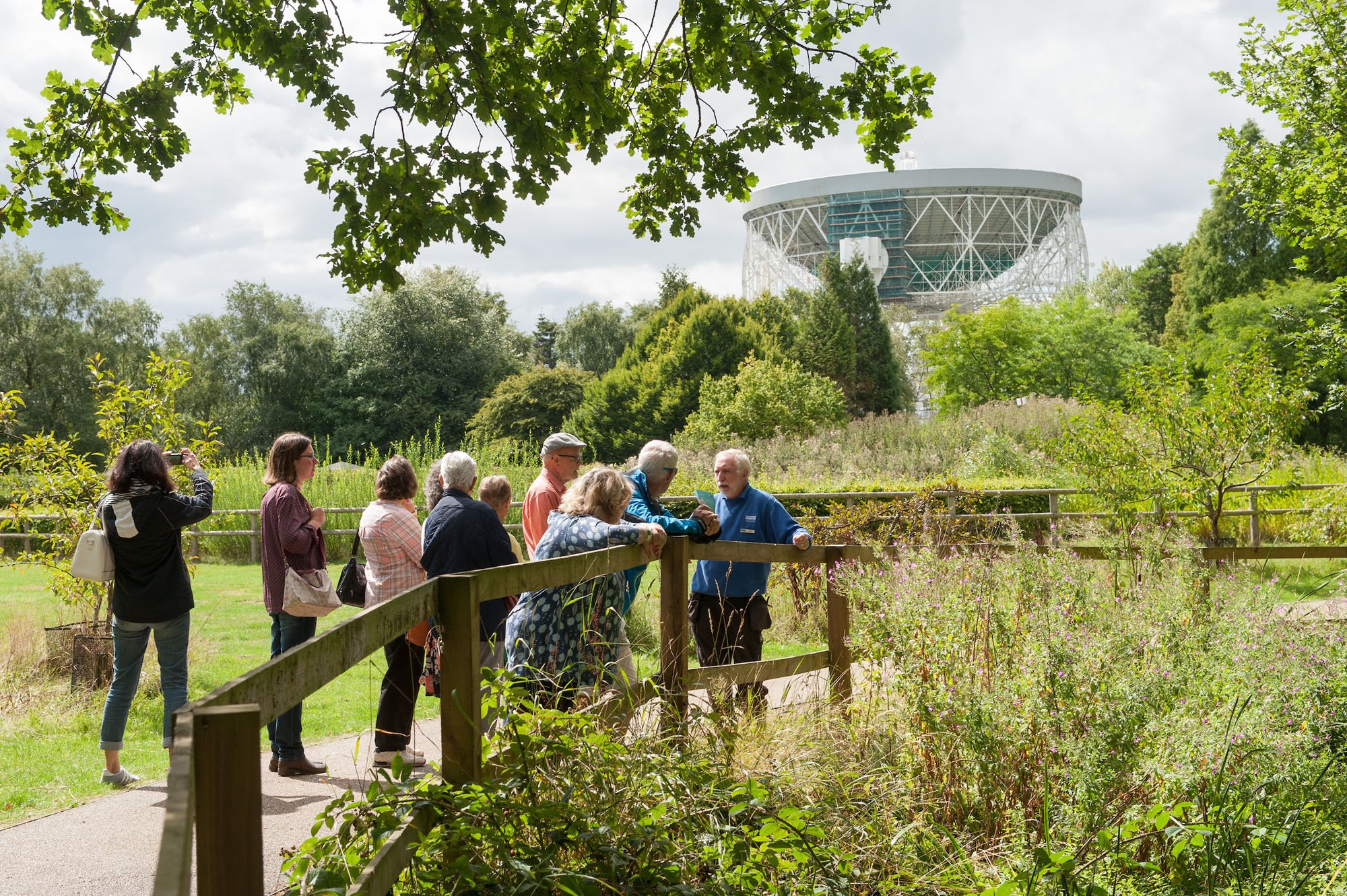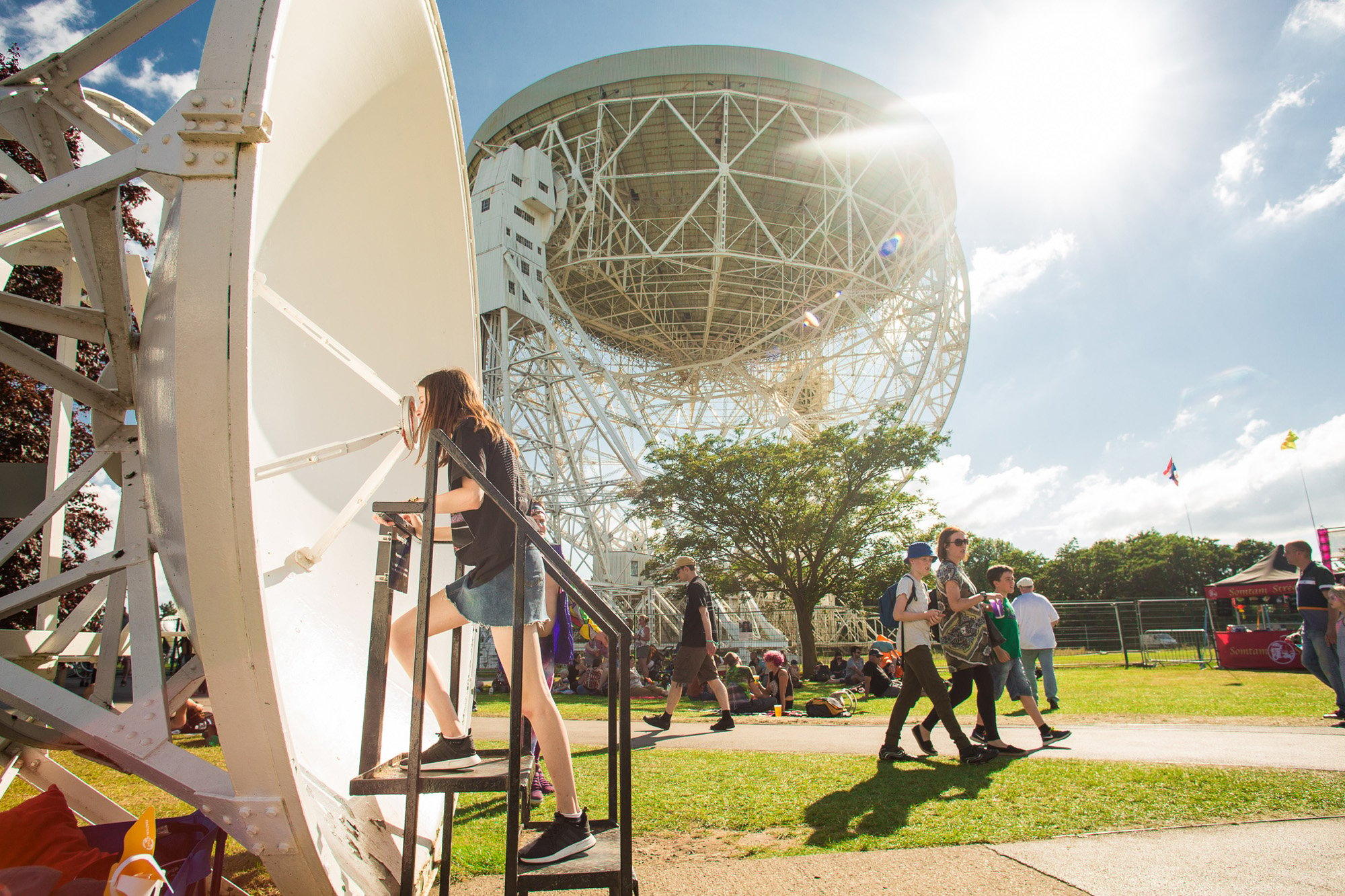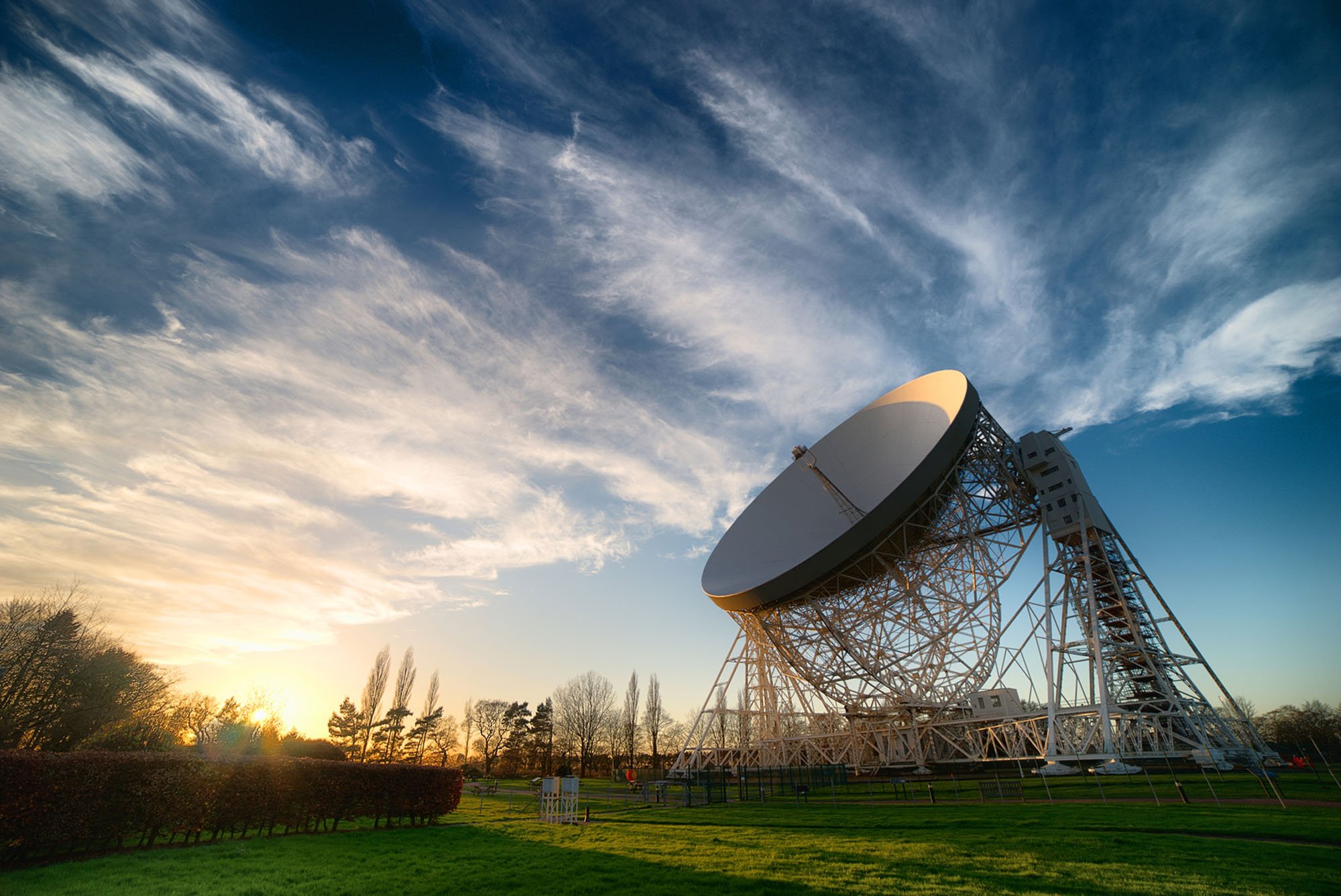Home → What’s On → Press Release → Jodrell Bank added to UNESCO World Heritage List
- Jodrell Bank Observatory in Cheshire has been named as the UK’s newest UNESCO World Heritage Site.
- The observatory becomes the UK’s 32nd site to be added to the prestigious list.
- New status recognises Jodrell Bank’s role in transforming our understanding of the Universe.
Professor Tim O’Brien, Associate Director at Jodrell Bank Observatory, and Professor Teresa Anderson, Director at Jodrell Bank Observatory Center, react to the news of Jodrell Bank being named a World Heritage Site by UNESCO.
Jodrell Bank Observatory in Cheshire has been added to the UNESCO World Heritage List.
The observatory becomes the 32nd UNESCO World Heritage Site in the UK and joins the prestigious list alongside international sites such as Machu Picchu, the Great Wall of China and the Taj Mahal.
Jodrell Bank, owned by the University of Manchester, is famous as the home of the Lovell Telescope, the world’s third largest steerable radio telescope. Completed in 1957, the dish was the largest of its kind anywhere in the world until 1973 and was the catalyst for the construction of many other large scale satellite dishes.
The Lovell Telescope’s first act was to track the Soviet Union’s Sputnik, the world’s first artificial satellite. Today, Jodrell operates the UK’s national e-MERLIN radio telescope and hosts the global headquarters of the Square Kilometre Array, a radio telescope project that will build the world’s largest telescope, comprised of a network of instruments sited in South Africa and Australia.
The addition of Jodrell Bank to the UNESCO World Heritage List is in recognition of its outstanding scientific heritage including its pioneering role in the development of radio astronomy and its work in tracking spacecraft in the early space race, and its research into quasars, pulsars and gravitational lenses. The site has evidence of every stage of the history of radio astronomy, from its emergence as a new science in the 1940s through to the present day.

Tour of the grounds and gardens at Jodrell Bank, the Lovell Telescope in the background. Photo courtesy of Jodrell Bank.
HERITAGE MINISTER REBECCA POW SAID:
“I am delighted that Jodrell Bank has become the UK’s 32nd UNESCO World Heritage Site. The research completed here has transformed our understanding of the Universe and it is right that this is recognised.”
“Today’s announcement will make sure that this remarkable site will continue to inspire young scientists and astronomers all over the world.”

Jodrell Bank is the earliest radio astronomy observatory in the world still in existence. Photo courtesy of Jodrell Bank.
TERESA ANDERSON, DIRECTOR OF THE JODRELL BANK DISCOVERY CENTRE SAID:
“This is wonderful news and a great day in the history of Jodrell Bank. It honours the pioneering work of Sir Bernard Lovell and the early scientists here, together with the world-leading research that continues to this day.”
“Receiving this recognition will help us tell their story and the story of the communities connected to the site both across the UK and worldwide.”
PROFESSOR DAME NANCY ROTHWELL, PRESIDENT AND VICE-CHANCELLOR OF THE UNIVERSITY OF MANCHESTER SAID:
“I’m absolutely delighted to hear that the Jodrell Bank Observatory site has been assigned World Heritage status by UNESCO. This is fitting recognition of the history of science and discovery at Jodrell Bank, and the work that continues today.”
“Indeed, the site is fantastic for the University because of its heritage, its teaching and its research, and also because it is a place where many members of the public come to learn and be inspired about science.”

Jodrell Bank is the earliest radio astronomy observatory in the world still in existence. Photo courtesy of Jodrell Bank.
In 2017 the Department for Digital, Culture, Media and Sport (DCMS) increased the Observatory’s recognition in the National Heritage List for England. The Mark II Telescope joined the Lovell Telescope in being listed at Grade I, the highest form of protection, with a further five buildings listed at Grade II. Together, these listings recognised the pivotal role played by the Observatory in the development of the science of radio astronomy, revolutionising our understanding of the universe.
The decision to add Jodrell Bank Observatory to the UNESCO World Heritage List was taken at the 43rd session of the World Heritage Committee in Baku, Azerbaijan.

The inside of the bowl, Lovell Telescope. Photo courtesy of Jodrell Bank.
MINISTER AND AMBASSADOR OF UNITED KINGDOM OF GREAT-BRITAIN AND NORTHERN IRELAND TO UNESCO, MATTHEW LODGE, SAID:
“Congratulations to the Jodrell Bank Observatory for becoming a UNESCO World Heritage Site.
UNESCO World Heritage Sites celebrate and safeguard our shared past. They are places of distinct cultural and natural significance for the development of human history. I am delighted that Jodrell Bank Observatory is becoming one of them.
Set in rural Cheshire, Jodrell Bank is one of the earliest sites for radio astronomy and the world’s only site with evidence of every stage of the emergence of this new science since 1945.
It is an icon of world-class science and engineering with a history of tremendous scientific achievements that have revolutionised our understanding of the Universe. The site is home to a vast variety of early scientific equipment, buildings and discoveries such as the Lovell Telescope, the world’s largest telescope in 1957 and the third largest today and a bearing witness of the UK’s pivotal role in radio astronomy.
But Jodrell Bank is more than just a relic from the post-war flourishing of research technology. It is also a beacon and centre of excellence for world-leading research and education, reminding us that there is far more to the Universe than meets the eye. It is part of one of the UK’s leading universities, the University of Manchester, and hub of the UK’s national array of seven radio telescopes.
And let us remember that, as befits a UNESCO World Heritage Site, Jodrell Bank is a symbol of international collaboration and the exchange of ideas and values. The Observatory cooperates with leading institutions and scientists worldwide to help us all to better understand our place in the Universe through cutting-edge discoveries in astronomy, quantum optics, satellite communications and many other fields. It also welcomes numerous visitors each year to capture their imagination and engage the world with science.
Jodrell Bank’s rich scientific heritage bears testimony to the UK’s leading role in science research worldwide. Becoming the UK’s 32 UNESCO World Heritage Site is a great accolade for the Observatory, Cheshire and all of the UK.”
HELEN MACLAGAN OBE, NON-EXECUTIVE DIRECTOR FOR CULTURE THE UK NATIONAL COMMISSION FOR UNESCO, SAID:
“I’m delighted to see Jodrell Bank Observatory join the World Heritage List. The contrast between this property and the English Lake District, the previous UK inscription, demonstrates vividly the breadth and diversity of global heritage. This, the first 20th Century Observatory on the World Heritage List now sits alongside Stonehenge and Avebury – one of the UK’s first World Heritage inscriptions – whose astronomical significance is still being explored.
At Jodrell Bank, the birthplace of radio-astronomy, the story of the development of this science is written in the landscape – and what a story it is, from early experiment to international scientific collaboration, featuring inspirational individuals such as Bernard Lovell and many others.
It’s a wonderful and atmospheric place, as well as an iconic feature in the local landscape – and indeed further afield, as evidenced when it featured on the series of British Technology postage stamps in 1966.
Jodrell Bank is a hugely worthy addition to the World Heritage List. The site already has a well-established reputation for public engagement and has much to bring to the portfolio of existing UNESCO designations within the UK. Many congratulations to the dedicated and hard-working team, who worked faster than some thought possible – and welcome aboard!”

The Blue Dot Festival, held every summer at Jodrell Bank. Photo courtesy of Jodrell Bank.
JAMES BRIDGE, SECRETARY-GENERAL AND CHIEF EXECUTIVE AND UK NATIONAL COMMISSION FOR UNESCO, SAID:
“Congratulations to Jodrell Bank UNESCO World Heritage Site!
The recognition by UNESCO of the outstanding universal value of Jodrell Bank, a University of Manchester body, symbolises the UK’s and its universities’, engineers’, educators’ and scientists’ role both in contributing to the foundations and cutting edge of science and engineering in the past and a how they, as part of a global community, will build on this legacy in the future”.
Already world famous to the scientific and engineering community, UNESCO recognition acknowledges Jodrell Bank’s contribution to building educational, scientific and cultural and communication links between the world’s people’s, nations and multilateral bodies, as part of UNESCO’s constitutional aim of building the defences of peace in the minds of women and men.”
NOTES TO EDITORS
Jodrell Bank is the earliest radio astronomy observatory in the world still in existence. It includes evidence of every stage of the post-1945 ground-breaking development of radio astronomy, which has revolutionised our understanding of the Universe.
At its heart is the Lovell Telescope, which has been quietly probing the depths of space since 1957 and stands as a symbol of our wish to understand the universe in which we live. Even now, it remains one of the biggest and most powerful radio telescopes in the world, and has unlocked a parallel universe of violent explosions, pulsars, neurons, and proof of some of the most important scientific theories of the universe.
The Department for Digital, Culture, Media and Sport is responsible for meeting the requirements of the World Heritage Convention within the UK. This includes maintaining and reviewing the Tentative List of sites, formally nominating new sites, and ensuring existing sites are conserved, protected and given a life in the community.
The University of Manchester was awarded £12.1million from the National Lottery Heritage Fund and a further £4m from the Department for Culture, Media and Sport (DCMS) in 2018 for a new Discovery Centre at Jodrell Bank, Cheshire. Named ‘First Light at Jodrell Bank’ the project is creating a spectacular new gallery building to promote and celebrate the observatory’s world-leading place in the history of astronomy.
The other UNESCO World Heritage Sites in the UK are:
Cultural:
- Blaenavon Industrial Landscape (2000)
- Blenheim Palace (1987)
- Canterbury Cathedral, St Augustine’s Abbey, and St Martin’s Church (1988)
- Castles and Town Walls of King Edward in Gwynedd (1986)
- City of Bath (1987)
- Cornwall and West Devon Mining Landscape (2006)
- Derwent Valley Mills (2001)
- Durham Castle and Cathedral (1986)
- Frontiers of the Roman Empire (1987,2005,2008)
- Gorham’s Cave Complex (2016)
- Heart of Neolithic Orkney (1999)
- Historic Town of St George and Related Fortifications, Bermuda (2000)
- Ironbridge Gorge (1986)
- Liverpool – Maritime Mercantile City (2004)
- Maritime Greenwich (1997)
- New Lanark (2001)
- Old and New Towns of Edinburgh (1995)
- Palace of Westminster and Westminster Abbey including Saint Margaret’s Church (1987)
- Pontcysyllte Aqueduct and Canal (2009)
- Royal Botanic Gardens, Kew (2003)
- Saltaire (2001)
- Stonehenge, Avebury and Associated Sites (1986)
- Studley Royal Park including the Ruins of Fountains Abbey (1986)
- The English Lake District (2017)
- The Forth Bridge (2015)
- Tower of London (1988)
Natural:
- Dorset and East Devon Coast (2001)
- Giant’s Causeway and Causeway Coast (1986)
- Gough and Inaccessible Islands (1995,2004)
- Henderson Island (1988)
Natural:
- St Kilda (1986,2004, 2005)
Home → What’s On → Press Release → Jodrell Bank added to UNESCO World Heritage List

